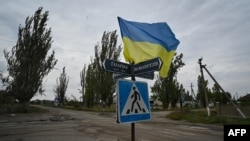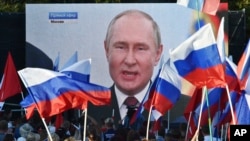On October 19, Russian President Vladimir Putin declared martial law in four Ukrainian regions Moscow is attempting to illegally annex. Putin also introduced heightened security regimes in Russian-occupied Crimea and Russian regions bordering Ukraine.
Putin sought to justify the martial law declaration as a response to Ukraine ostensibly ignoring the sentiment of the people in regions occupied by Russian troops. Last month, Moscow staged rigged referendums in four provinces to join Russia.
“The Kyiv regime, as you know, refused to recognize the will and choice of the people, and rejects any proposals for negotiations. On the contrary, shelling continues; civilians are dying,” Putin said.
“Neo-Nazis are frankly using terrorist methods – sabotage at vital facilities and arranging assassination attempts against local authorities. Like their ideological predecessors – Bandera, Hitler's accomplices – they are trying to create a bandit underground, sending sabotage groups into our territory.”
Putin’s statement weaves together multiple falsehoods, including the widely debunked smear that Ukraine’s government and troops are neo-Nazis.
The statement obscures Russia’s flagging military fortunes in parts of occupied Ukraine where Putin declared martial law. And it distracts from Russia’s renewed attacks on civilian infrastructure and long trail of war crime allegations in Ukraine.
Russian law states that martial law can be declared in response to “aggression against the Russian Federation or a direct threat of aggression.”
It defines “aggression” as “the application of armed force by a foreign state (group of states) against the sovereignty, political independence and territorial integrity of the Russian Federation or in any other way, incompatible with the [United Nations] Charter.”
Putin has turned this on its head by imposing martial law inside Ukraine after launching a full-scale military invasion – in other words, as part of a Russian war of aggression against Ukraine’s sovereignty, independence and territorial integrity.
According to the presidential martial law decree, Russian authorities may “implement measures to meet the needs of the Armed Forces of the Russian Federation” and other Russia-backed forces; “carry out mobilization measures in the economic sphere;” and implement other “measures for civil defense.”
In practice, these sweeping powers could allow resettling Ukrainians against their will, restricting their movements, seizing their property, imposing curfews and even forcibly conscripting them into the Russian army.
Heightened security regimes, including restrictions on movement, have been enacted in the Russian regions of Belgorod, Bryansk, Kursk, Krasnodar, Rostov and Voronezh, all adjacent to Ukraine.
In September, Moscow conducted hastily organized referendums in four Ukrainian border provinces – Donetsk, Luhansk, Zaporizhzhia and Kherson— to justify its attempted land grab.
Regarding the “will and choice” of residents, those referenda were characterized by Moscow-installed officials and armed soldiers going door-to-door to collect votes.
Photos have surfaced showing soldiers standing over people filling out their ballots.
Witnesses in recently liberated territories confirmed that Russian authorities had intimidated the referendum voters.
A woman in Enerhodar, Zaporizhzhia region, told the BBC she had to cast her vote “verbally” and then a soldier filled out the ballot and kept it.
“The referendum is taking place in the occupied city of Kherson under the muzzle of an automatic rifle,” Galina Luhova, head of the Kherson City Military Administration, told The Washington Post from Ukrainian-held territory.
“They ring the doorbell of apartments, knock down the doors of those who don’t open them and demand that people come out and put a mark that they agree to join the Russian Federation.”
Many Ukrainians had already fled before the referendums, and Russia did not have full control over any of the regions at the time of the sham votes. Military hostilities were still ongoing in all four provinces.
In Zaporizhzhia, for example, at the time the referendum was held, Ukraine still controlled Zaporizhzhia city, which had a pre-war population of 700,000.
Two of the provinces where referendums were held, Luhansk and Donetsk, are already home to self-proclaimed “people’s republics” – Kremlin-controlled breakaway areas declared after Russia’s clandestine invasion of Crimea in 2014.
Since Russian proxy forces took over those areas in 2014, the U.N. human rights watchdog said basic civil rights have been “severely restricted,” with pro-Ukrainian views essentially criminalized.
The referendums are also illegal under Ukrainian and international law.
Earlier this month, the United Nations General Assembly passed a resolution by a large majority calling on countries not to recognize Russia’s claim to the four regions.
The resolution said the four regions were “temporarily occupied by Russia” in violation of Ukraine's territorial integrity, sovereignty and political independence. The resolution demanded that Moscow reverse its “attempted illegal annexation.”
The referendums corresponded with Russian setbacks on the battlefield.
The same day referendums were announced, Putin also ordered a “partial” mobilization in Russia amid a Ukrainian counteroffensive that liberated more than 3,000 square kilometers of Ukrainian territory. Russian troops were pushed out of the northeastern Kharkiv region, and advances continue elsewhere.
Putin’s mobilization has sparked fear across Russia, triggering a mass exodus of Russian men of military age.
Likewise, Putin’s martial law declaration comes amid signs that Ukraine’s campaign to retake Kherson, in southern Ukraine, is gathering steam.
On October 18, the Moscow-installed deputy administrator of Kherson, Kirill Stremousov, warned “the battle of Kherson” would soon begin, and told civilians to evacuate the city of Kherson “as soon as possible.”
Vladimir Saldo, the head of the city’s Moscow-installed military–civilian administration, said 50,000-60,000 civilians would leave Kherson and surrounding towns in the coming days, along with occupation administration officials.
The Ukrainian president's chief of staff, Andriy Yermak, accused Russia of staging a propaganda show to convince residents of Kherson to flee by scaring them “with fake messages about the shelling of the city by our army.”
Analysts say Putin is trying to compel more Ukrainians to fight in the Russian army. Russia-backed fighters in occupied areas of Ukraine’s eastern Donbas region have already forced local men, including Ukrainian citizens, to join the military.
Rights activists say Crimean Tatars, who are largely pro-Ukrainian, have disproportionately faced conscription in Russian-occupied Crimea.
Forcibly conscripting Ukrainians and then forcing those conscripts to relocate to Russia would violate the Geneva Convention.






